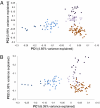Complex population structure in African village dogs and its implications for inferring dog domestication history
- PMID: 19666600
- PMCID: PMC2728993
- DOI: 10.1073/pnas.0902129106
Complex population structure in African village dogs and its implications for inferring dog domestication history
Abstract
High genetic diversity of East Asian village dogs has recently been used to argue for an East Asian origin of the domestic dog. However, global village dog genetic diversity and the extent to which semiferal village dogs represent distinct, indigenous populations instead of admixtures of various dog breeds has not been quantified. Understanding these issues is critical to properly reconstructing the timing, number, and locations of dog domestication. To address these questions, we sampled 318 village dogs from 7 regions in Egypt, Uganda, and Namibia, measuring genetic diversity >680 bp of the mitochondrial D-loop, 300 SNPs, and 89 microsatellite markers. We also analyzed breed dogs, including putatively African breeds (Afghan hounds, Basenjis, Pharaoh hounds, Rhodesian ridgebacks, and Salukis), Puerto Rican street dogs, and mixed breed dogs from the United States. Village dogs from most African regions appear genetically distinct from non-native breed and mixed-breed dogs, although some individuals cluster genetically with Puerto Rican dogs or United States breed mixes instead of with neighboring village dogs. Thus, African village dogs are a mosaic of indigenous dogs descended from early migrants to Africa, and non-native, breed-admixed individuals. Among putatively African breeds, Pharaoh hounds, and Rhodesian ridgebacks clustered with non-native rather than indigenous African dogs, suggesting they have predominantly non-African origins. Surprisingly, we find similar mtDNA haplotype diversity in African and East Asian village dogs, potentially calling into question the hypothesis of an East Asian origin for dog domestication.
Conflict of interest statement
Conflict of interest statement: For some of this project, we utilized the Wisdom MX product (MARS Inc.) for detecting breed-admixed ancestry. P.G.J. was as employee of MARS overseeing Wisdom development, C.D.B. was paid consultant for MARS during its development, and E.A.O. is a licenser of the patent.
Figures





Comment in
-
Dog genome evolution: a strategy to segregate biogeographic effects from human selection.Proc Natl Acad Sci U S A. 2010 Jan 26;107(4):E11. doi: 10.1073/pnas.0910552107. Epub 2010 Jan 14. Proc Natl Acad Sci U S A. 2010. PMID: 20080606 Free PMC article. No abstract available.
References
-
- Wayne R. Consequences of domestication: Morphological diversity of the dog. In: Ruvinsky A, Sampson J, editors. The Genetics of the Dog. Oxon, UK: CABI Publishing; 2001. pp. 43–60.
-
- Clutton-Brock J. Origins of the dog: Domestication and early history. In: Serpell J, editor. The Domestic Dog, Its Evolution, Behavior and Interactions with People. CUP, Cambridge: 1995. pp. 7–20.
-
- Vilà C, Maldonado J, Wayne R. Phylogenetic relationships, evolution, and genetic diversity of the domestic dog. J Hered. 1999;90:71–77. - PubMed
-
- Germonpré M, et al. Fossil dogs and wolves from Palaeolithic sites in Belgium, the Ukraine and Russia: Osteometry, ancient DNA and stable isotopes. J Arch Sci. 2009;36:473–490.
-
- Vilà C, et al. Multiple and ancient origins of the domestic dog. Science. 1997;276:1687–1689. - PubMed
Publication types
MeSH terms
Substances
Associated data
- Actions
- Actions
- Actions
- Actions
- Actions
- Actions
- Actions
- Actions
- Actions
- Actions
- Actions
- Actions
- Actions
- Actions
- Actions
- Actions
- Actions
- Actions
- Actions
- Actions
- Actions
- Actions
- Actions
- Actions
- Actions
- Actions
- Actions
- Actions
- Actions
- Actions
- Actions
- Actions
- Actions
- Actions
- Actions
- Actions
- Actions
- Actions
- Actions
- Actions
- Actions
- Actions
- Actions
- Actions
- Actions
- Actions
- Actions
- Actions
- Actions
- Actions
LinkOut - more resources
Full Text Sources

